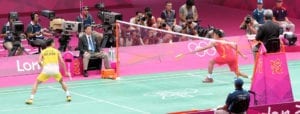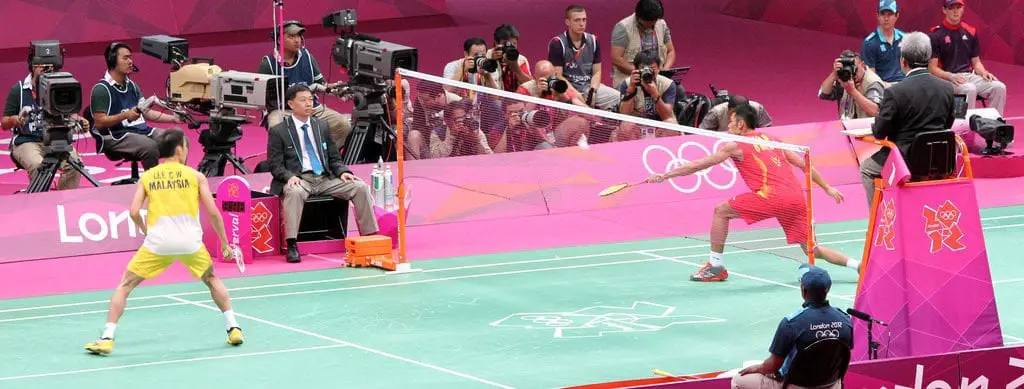In the game of badminton, or specifically singles, strategy is heavily involved. It is what’s going to let you retain more energy and waste up the energy of your opponents.
As a singles player I have found many strategies that prove to be very useful and I want to share some of them with you!
Making People Move
This one is the most basic strategy in all of badminton. Hit the shuttle to places where your opponent isn’t. There are many ways you can do this.
Some examples of how to do this are hitting a clear/lift after you drop/net shot, driving/smashing side to side, driving to a corner and then net shotting and many more. It’s fairly simplistic, just play your shots to different places instead of hitting it into the same place.
Play to the corners and your opponent will surely have a hard time responding to your shots.
Attack
When attacking in singles, I want you to keep making people move in your mind. You want to put as much pressure as possible onto your opponent to eventually win the rally when attacking in singles. Before we get into how to attack, first you should learn about how to set up a situation where you’re attacking.
To be in an attacking situation, usually you should be playing overhead shots like smashes or drops and also be in a position where you’re the one in control of the game and making your opponent scramble for the shuttle. Ways to get into this position is to force your opponent to play high lifts and clears.
You can force your opponent into playing high lifts and clears in many ways. The tactics I like to use are a combination of driving to the back corners and playing net shots that are extremely tight to the net. When you play fast shots to the back, you force your opponent to play drops and clears. If they drop then you can play a net shot or drive again except cross court. Doing a mix of these will eventually force your opponent to lift the shuttle or clear it.
Once you’re in the attacking position, the standard attack goes like this: smash, net kill/net shot, smash, net kill. Sometimes it goes longer but usually you should win the point after your first net kill or second smash. You also want to play cross court shots. So after your first smash, you should net kill or net shot cross court, and then smash straight. This is important because if you hit to different areas, your opponent will have a much harder time defending than if you hit it to one spot.
Of course there are variations that you can and should play but we’ll talk about that later.
Another thing to mention is when you’re attacking (or playing badminton in general), you should move as fast as you can. After you smash, instantly follow up by running to the front and net killing and then preparing for the next attack. It happens way too many times when a player would smash and think it’ll win the rally there but in fact the opponent blocks it and gets a point. You want to maximize the points you get when you’re in attacking position.
Defense
You can’t always be attacking. Although attacking can get you lots of points, you lose most of your stamina when attacking and sometimes it’s your opponent’s turn to attack. This means you have to have a good defense. Ever heard of the saying, the best offense is the best defense? What about the best defense is the best offense? Probably heard of the second one less but in badminton, it’s true!
Generally you don’t want to put yourself into the defensive position but it’s usually done through playing lifts and clears. Once you’re in this position, you want to position yourself in the middle, slightly towards the area to receive a straight smash (fastest smash). You want to have a lower center of gravity and be ready for any type of shot. Just before your opponent hits the shuttle, take a split step. This will make you more mobile and prepared to defend.
Now let’s talk about what kind of shots you should play. Usually you play a block or net shot to defend. When defending, try not to make your net shots and blocks too high above the net. Making it too high gives your opponent the opportunity to net kill and end the rally. If you can, also try to block cross court occasionally. This will make your opponent lose more stamina and adds a lot of pressure.
Also, try to make as little movements as possible. Don’t shift your body weight all into one position because that will make it a lot harder to defend against the next shot. You want to stretch out as much as possible and move back to the middle as fast as possible too.
Variations
Now here are the variations. What I mean about variations is, you don’t want to play the same type of strategy and shots all the time. If your opponents are smart and good enough, they’ll adapt to it and also playing the same strategy all the time makes badminton a little boring. You always want to change it up a little.
Here’s an example of attacking with variation. To set yourself up into an attacking position, you can play all sorts of techniques. Instead of playing my strategy of driving to corners and net shotting, you could also drop or even clear and lift. This is all dependent on experience, your personal skill, and your opponent’s skill so there’s not much more I can say. When you’re actually attacking, a few tips I have is to change it up occasionally and where to hit it. Don’t do it too much or the opponent will notice but just occasionally, do a slice drop shot instead of a smash. You can really fake your opponent out with it. When you are smashing, try to smash straight and aim for the sideline but there are a few variations you can use. Occasionally smash cross court if you notice your opponent is heavily positioned to defend a straight smash and also sometimes you should smash at your opponent specifically between his racket arm if your opponent is tall.
As for defense, in singles there really isn’t much to talk about. Just try to block cross court occasionally to change it up. There’s also a shot that’s used more in women’s singles than men’s and that is a drive block. This is when you drive your opponent’s smash. Usually this is useful in making a quick turn to offense.
Another quick note is deceptions. Don’t fake shots too much, try to actually play the shot sometimes too. This will pressure the opponent to be on his toes all the time because he won’t know what type of shot you’re going to play. Common deceptions you can use in your game include, faking a net kill and playing a net shot, faking a net shot and playing a drive, and the famous faking a smash to play a slice drop shot.
Conclusion
With these strategies, you should have a good start on winning in singles. One thing to mention is that this isn’t everything. Like I mentioned in the variation section, strategy comes with experience as well as knowing your own and opponent’s play style.
Keep on playing and practicing and you will definitely get good at badminton. If you have any questions or comments, please feel free to leave them below, and as always, good luck in your games and have a great day!

